Whether you are a blogger or a website owner, you must have often heard about search engine optimization (SEO). Search engine optimization, or SEO, increases the volume and quality of organic traffic a website receives from search results. It has the power to enhance search visibility by improving the website rank in search engine result pages (SERPs). In short, SEO defines the success of every online business.
This article will cover SEO in-depth. I will also guide you through the steps required to optimize websites for search engines.
What is Search Engine Optimization?
Search engine optimization, more commonly known as SEO, is the set of practices that aim to improve the appearance and rank of websites in search engine result pages. Simply put, it is the art of making changes to your website that results in better search engine rankings, increases organic traffic to your site, and improves conversions.
SEO ensures search engines like Google can conveniently discover, crawl, and index all your web pages and rank them for relevant search queries. The higher you rank in SERPs, the more people visit your site.
Benefits of SEO
Every blog and website needs search engine optimization. SEO can generate organic traffic by helping your site rank higher in organic search results. Organic search results refer to the results or listings appearing on search engine result pages when you search for something using keywords. These are not advertisements but search results matching your search keywords.
Organic traffic refers to the traffic generated because of the search users perform in search engines. It can make or break the difference for your online business because most online experiences begin with a search engine.
Therefore, you should optimize your website, ensuring a higher rank in Google search results targeting a wide range of audiences.
How to Do Search Engine Optimization?
There are five easy steps that you must follow to make your website search optimized.
Step 1: On-Page SEO
On-page search engine optimization is the first and most critical step in optimizing your site. It is the practice of optimizing the content and HTML of web pages. The following elements of the website require SEO:
Keyword or Keyword Phrases
Online users heavily rely on search engines to find information, products, and services. The right keywords in your web pages can get you the right traffic. But what makes it challenging is figuring out keyword phrases used by searchers.
Instead of relying on your knowledge or gut feeling, do some research. Plenty of keyword research tools available can be of great help. For example, SEMrush, Serpstat, and SpyFu are widely used SEO tools for keyword research. They are used to determine the average monthly volume of keywords along with their search difficulty.
Below is a screenshot of the keyword overview in SEMrush.
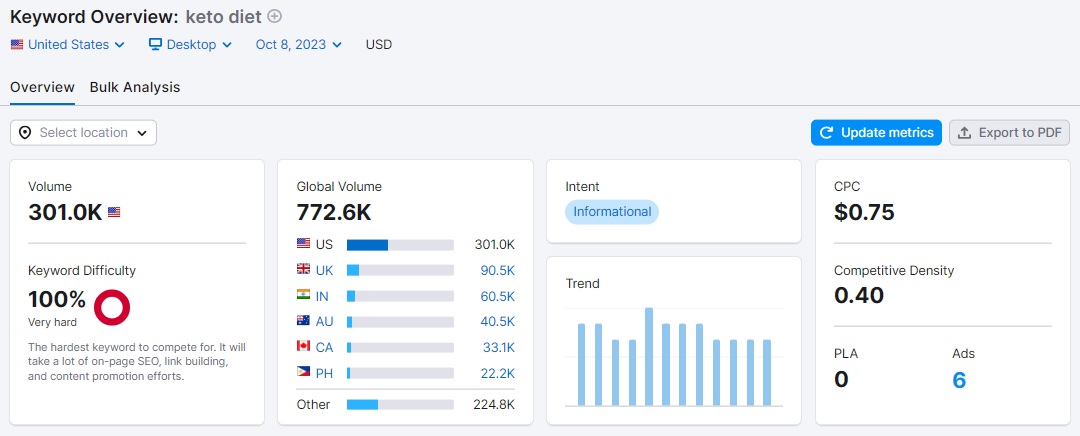
Please remember that high-volume keywords may require more work to rank higher in Google search results if your website is related to a highly competitive niche.
While using low-volume keywords may not draw any searchers to your site. Therefore, to rank your site higher in SERPs (Search engine research pages), target long-tail, specific keywords or phrases with low competition.
KWFinder is a popular tool for finding long-tail keywords. LongTailPro is another tool that you can use to find less competitive long-tail keywords.
Title Tag
Search engines get to know what your page is about through the title page. The title tag appears as the title in search engine results. Like any other tag, the title tag appears in the web page HTML between the <Head> </Head> tag.
An ideal title tag contains less than 70 characters and has the focus keyword. It must relate to the specific web page and best describe its contents. A title tag looks like this:
<title>Digital Success–How To Rank on The First Page of Google Search Results</title>
Meta Description
Getting on the first page of Google is essential, but it is of greater significance to get clicked through. The meta description appears in the SERP listing right under the title. It tells search engines about the page contents and helps searchers know whether the page has their desired information. A meta description looks like this:
<meta name= “description” content= “A complete guide to achieving a higher rank. Use long-tail keywords to make your place among the high-profile websites already capitalizing on high-volume keywords”/>.
To optimize meta description, ensure it is less than 160 characters, includes the target keyword, and accurately and concisely describes what the page is about.
You can use free WordPress plugins, such as All in One SEO, Platinum SEO Pack, and SEO Yoast, to add title tags and Meta descriptions to different web pages if you have a WordPress website.
Header Tags
A good SEO website effectively uses HTML header tags. Header tags break down the content into sections and subsections. They are helpful for both search engines and readers to know about the contents of each section. Please keep in mind that there must be only one <H1> </H1>, while you can have multiple <H2></H2> up till <H6></H6> tags.
Images
If your content contains images, you should always use relevant keywords in the name and alt tags. For example, if your blog post is related to SEO optimization and it has an image, then the name and alt tag can be something like this:
<img src=”SEO-Optimization-Beginners-Guide.png” alt=”SEO Optimization for Bloggers” />
As a result of name and alt tags, your images will rank higher in search engine image results and will likely drive traffic to your website.
It is equally important to optimize the images by storing them in the correct format and compressing them. Smush is a popular WordPress that offers lossless image compression.
Internal and External Links
Internal and external links are essential elements of on-page search engine optimization.
Internal links assist search engines in finding new pages, making crawling efficient. They also pass authority from one page to another. Therefore, linking from a high authority page to a low authority page helps the latter rank higher in SERPs.
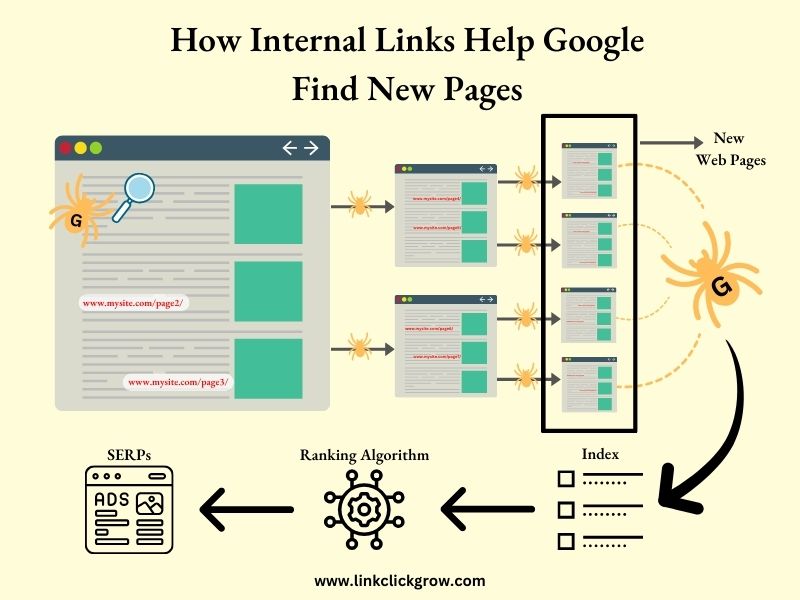
Most importantly, internal links help reduce bounce rates as they enable visitors to explore other site pages.
However, as the website grows, it may become challenging to include internal links. Therefore, I recommend using tools or plugins to create internal links, such as LinkWhisper, RankMath, and Internal Link Juicer.
Similarly, external links show the authority of your content. However, it is critical to cite sources or web pages that are credible and authentic. Ideally, you should include at least three external links in every blog post.
To optimize internal and external links, ensure the anchor text is short and reflects the contents of the linking page. Also, do not use generic anchor texts like ‘click here’.
Step 2: Create High-Quality Content
Your content must be unique and exciting to attract traffic. High-quality SEO content has the following features:
It Aligns with the Search Intent: SEO content delivers the information searchers seek. It matches the search intent and fulfills the requirements of searchers. Therefore, it is crucial to learn the intent behind the keyword before crafting content.
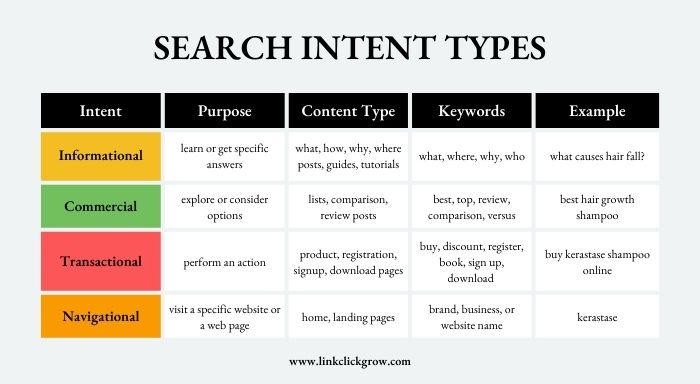
You can learn about the search intent by looking at the top ten Google search results. However, if you are conducting keyword research, checking Google results can be very time-consuming. Therefore, I recommend using a tool. For example, SEMrush’s Keyword Magic Tool displays a separate column that indicates the intent type for each keyword.
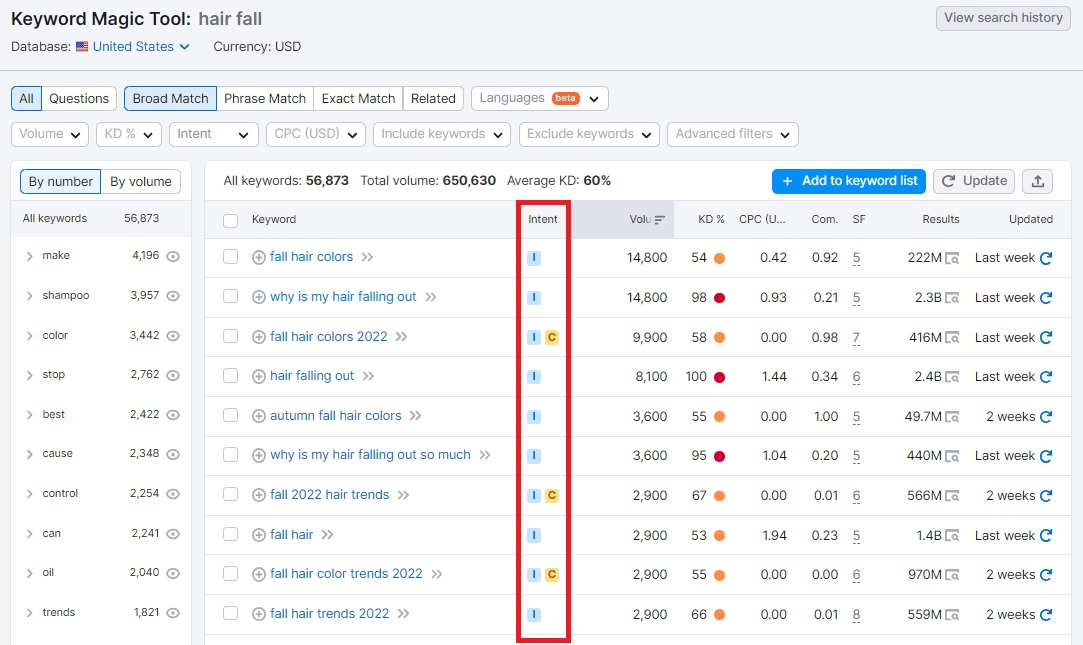
It is Comprehensive: SEO content covers the topic in-depth and provides all relevant information the searcher might need. Comprehensive content ensures all questions related to the topic are answered, enhancing user experience. It also helps search engines determine the context of the content.
It is User Friendly: User experience signals impact the SEO rankings of a webpage. To ensure your content is easy to read and consume, do the following:
- Structure content into headings.
- Use shorter paragraphs and sentences.
- Proofread content to ensure there are no grammatical mistakes. Grammarly, ProWritingAid, and WhiteSmoke are popular grammar checking tools that you can use to review your content.
It is Optimized for the Keyword: With time, search engine ranking algorithms have become intelligent. Now, stuffing content with keywords does not help you rank higher in SERPs. Instead, search engines consider other factors as well to understand the context of your content.
To ensure your content is SEO optimized, consider the following:
- Strategically include the keywords. Keywords should appear naturally in your content. Include them only when and where they add value to your content.
- Use LSI keywords to establish relevance. LSI keywords are semantically related keywords that help search engines determine the context and relevance of your content. To find LSI keywords, I recommend using LSIGraph.
- Include the target keyword in headings and subheadings.
Step 3: Off-Page SEO
Off-page or off-site search engine optimization comprises actions and practices outside the website to improve your ranking in SERPs (search engine result pages). It is significant, as it builds your website’s authority and increases trustworthiness.
Building Backlinks
Incoming links or backlinks are a significant factor that search engine algorithms consider when determining rank. Backlink, also known as the incoming link, links to your website from another site. When someone comes to your website using a link on another website, it is called a backlink.
One tip is to create more content because the more content you have, the more natural links you will receive. SEMrush is an effective tool most successful websites use to monitor your backlink campaign with your competitors to uncover missed link-building opportunities.
Following are a few of the many link-building techniques you can use to build backlinks:
Link Externally: Including external links in your posts to high-authority sites in your niche is an effective way to earn quality backlinks. Whenever you include an external link, contact the site owner and tell them how their post has benefited you. Providing them with a link to the post will also tempt them to share your post.
Build Broken Links: It is one of the most effective ways to build backlinks. A broken link is no longer valid and returns a 404 error when clicked. You can identify broken links in your niche, and if you have content that can replace that broken link, you can quickly earn backlinks. You can use SEMrush to find the broken links of competitor websites, the list of pages that refer to those links, and write customized emails to their web admins offering alternate links.
Link Gap Analysis: Link gap analysis is a backlink analysis technique for finding websites linking to more than one of your competitors. Those websites are likely to link to your website, too. Linkody is an excellent tool for tracking your backlink campaign and notifying you whenever your competitor gets a new link.
Write Testimonials: Writing testimonials is another way that can earn you backlinks. You can write good testimonials about a product or service and let them know about the testimonial. To let their audience know about your testimonial, they may publish it with a backlink on their site.
Guest Blogging
Guest blogging helps increase traffic to a blog, pushing it higher in the search results. It is one of the most effective off-page SEO strategies used by bloggers. For guest blogging, you need to identify sites/blogs for writing blog posts as a guest. Writing blog posts on other sites allows you to attract more audiences and increases your writing authority.
Social Media Marketing
Sharing your content on social can significantly increase the traffic to your website. If you are a blogger, you should always include share buttons on top of your blog so readers can share it, too. There are many tools available that you can use to add share buttons to your blog post. One of the most popular tools is Mashshare.
Step 4: Technical SEO
Technical SEO ensures search engines like Google can find, crawl, and index your web pages. It also includes a set of practices that aim to improve user experience.
Create SEO Friendly Site Structure
Your website should be easy to navigate to add value to the user experience. It should be simple and easy for users to go from the main page to other pages. The navigation links and menu should be self-explanatory and should have text. Websites that are complex and difficult to navigate have higher bounce rates.
Ideally, each webpage on your site should be three or fewer clicks away. You can achieve this by improving the internal linking structure.
Improve Page Load Speed
One factor considered by search engine algorithms is page load speed, making faster loading pages rank higher in search results. To determine the page load speed of your website, you can use Pingdom and Google Pagespeed Insights.
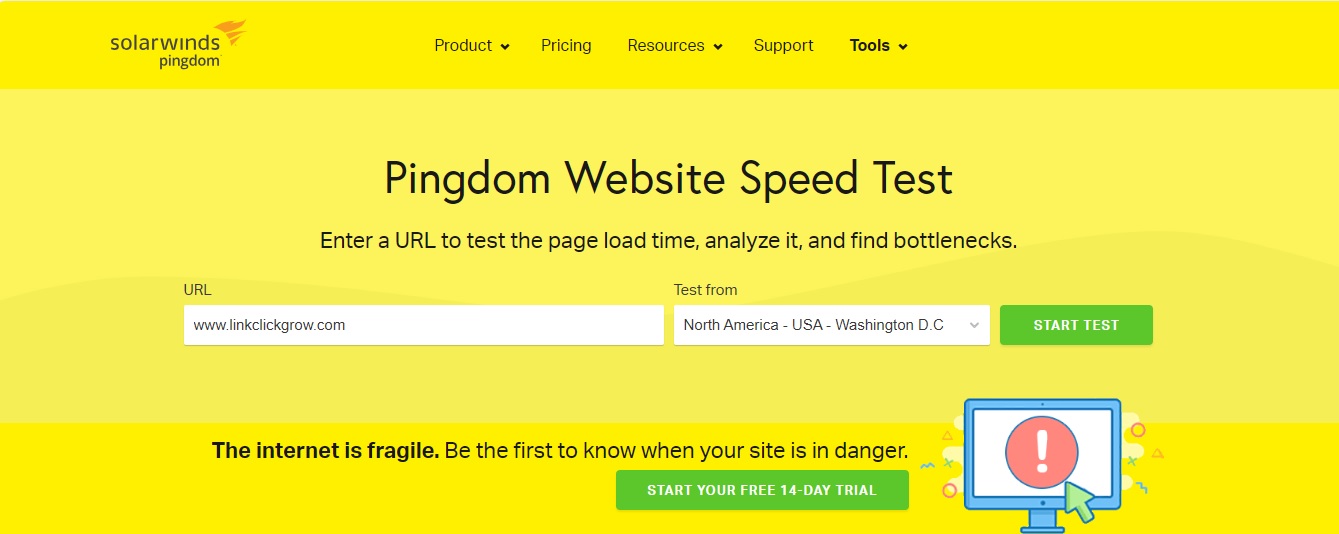
Page load speed is also crucial for a better user experience. Most online users leave a page that takes a long to load and prefer fast-loading websites. Nitropack is a popular platform that you can use to boost the speed of web pages.
Make the Website Mobile Friendly
In this modern era of technology, most users access the internet through their mobile devices. Therefore, a website must load correctly on mobile devices.
To optimize websites for mobile devices, consider the following best practices:
- Write short titles so they don’t get truncated on mobile screens.
- Highlight important information using bullets, lists, and tables.
- Use font styles and sizes that people can easily read.
- Use enough white spaces to make the design tempting.
- Replace wordy phrases with one-word substitutes.
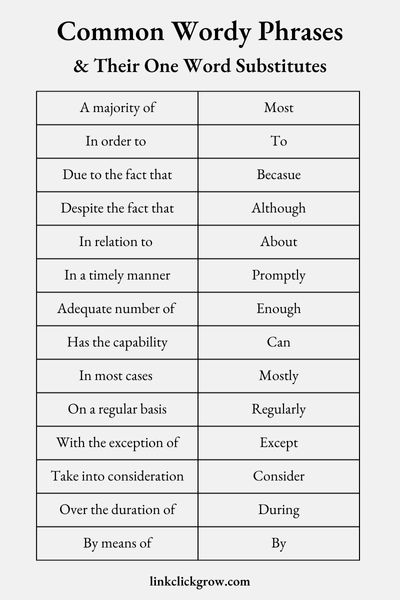
Submit Sitemap to Google
Sitemap helps search engines find web pages on your site. It is an XML file listing the URLs of all significant web pages you want Google to index. Submitting a sitemap to Google makes it easier for the search engine to discover, crawl, and index web pages.
Step 5: Monitoring and Analyzing SEO Progress
The last step is to analyze the progress of your SEO strategy to see if and how it requires necessary changes. Again, several SEO tools can give you a complete insight into the health and success of your website.
Most website analytic tools provide you with a unique computer-generated code that you will have to add to your web pages. With the help of this unique code, all activities on your web pages will be monitored and tracked.
Following are some tools that you can use to monitor and improve your SEO strategy:
Google Analytics: It is a free tool used to monitor website traffic. Some of the valuable statistics provided by Google Analytics are: how many visitors visit your website, how long they stay, the browser used by them, their location, etc.
SEMrush: SEMrush is a popular all-in-one SEO tool that offers multiple features like rank tracking, backlink analysis, keyword research, site audit, and competitor research. Serpstat is another platform for those looking for an alternative to SEMrush. It
Conclusion
Search engine optimization is critical for every site that aims to target a broader base of audiences. On-page, off-page, and technical SEO significantly improve your rank in search engine result pages. Therefore, you must optimize your site for search engines to increase visibility and traffic.


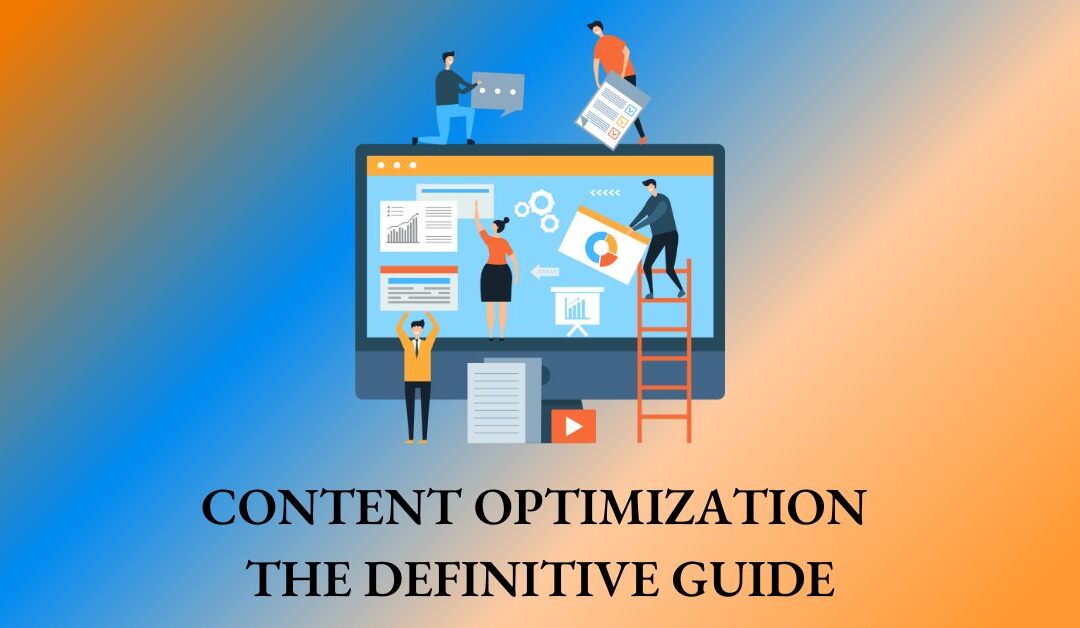
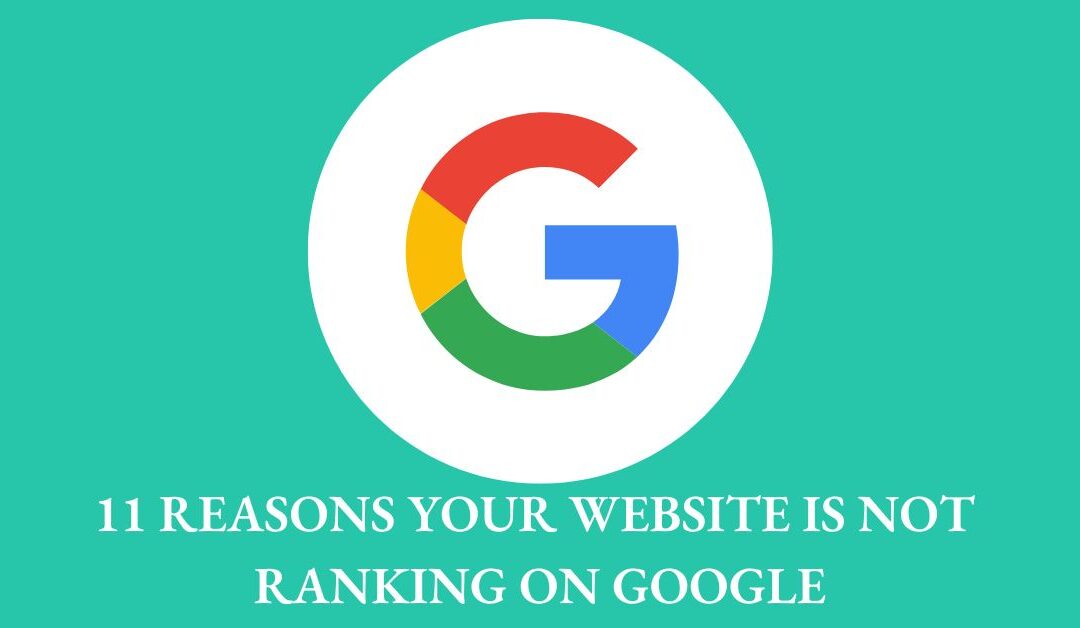
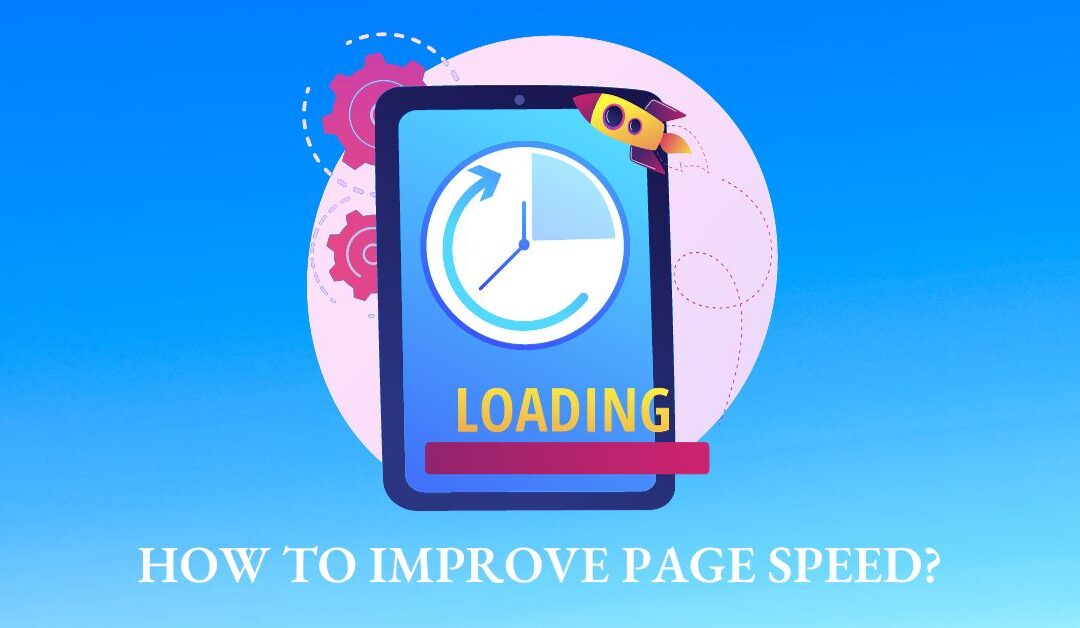

0 Comments